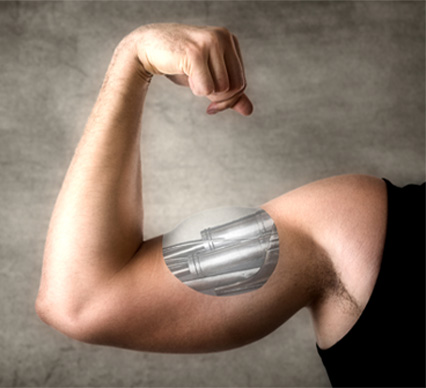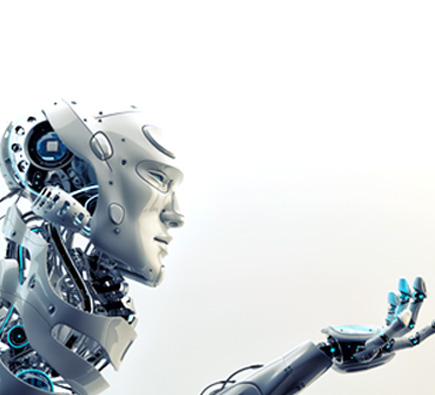Artificial Muscle인공근육
Artificial Muscle?
인공근육이란?

Artificial muscles are actuators which mimics the movement and function of muscles in the body, showing a reversible mechanical motion in response to external signals or stimulus. Our research is based on developing high-performance artificial muscle which are fast, strong, and mechanically robust. Research goal is the development of artificial muscles using biocompatible fiber like materials similar to muscle fibers considering future medical applications.
인공근육이란 생체인공근육의 움직임과 기능을 모방하여 외부 신호 및 자극에 반응하여 가역적인 기계적 움직임을 가지는 구동기를 뜻한다. 본 연구단은 빠른 속도와 강한 힘을 낼 수 있음과 동시에 기계적 물성이 강한 고성능 인공근육의 개발을 기본으로, 의학적 응용성을 고려하여 생체근육과 유사한 섬유구조의 생체적합 소재로 구성된 인공근육 소재를 개발하는 것을 목표로 연구하였다.
Actuator from Nature
자연을 모방한 인공근육
Our research group invented a yarn type torsional artificial muscle by twisting carbon nanotubes which has a diameter of 10 nm, bio-mimicking the rotational motion of elephant trunks and octopus legs.(Science, 2011) The torsional artificial muscle not only improved the contraction/relaxation properties of existing artificial muscles, but also displayed torsional actuation. This torsional artificial muscle converts electrical chemical energy to kinetic energy to actuate. Using only 2 V in liquid electrolytes, the torsional artificial muscle while loaded with weight 2000 time heavier than the actuator can show 590 rpm, which is similar to conventional motors. Also, by infiltrating paraffin wax into twisted carbon nanotube yarn a new paraffin artificial muscle was realized. (Science, 2012). This paraffin artificial muscle uses the thermal expansion/contraction property of paraffin and uses this volume change to actuate in air. The paraffin artificial muscle can torsionally actuate in air 20 times faster than artificial muscles actuated in liquid electrolytes and shows 30 times larger power than real muscles.
본 연구단은 코끼리가 물체를 들어 올리거나 문어가 다리로 회전운동을 하는 모습을 생체모방해 지름이 10nm정도에 불과한 탄소나노튜브들을 나선형으로 꼬아 실 형태의 회전이 가능한 인공근육을 만들었다(Science, 2011). 이 회전형 인공근육은 기존의 연구된 인공근육들이 갖고 있는 수축/이완 기능을 향상시켰을 뿐만 아니라 회전 운동을 가능하게 하였다. 회전 인공근육은 전기화학적 에너지를 운동에너지로 전환하여 구동된다. 낮은 2V의 전압을 인가하여 회전 인공근육은 액체 속에서 자신보다 2천배 무거운 물체를 부착해 분당 590회 회전할 수 있고 그 회전력은 상용화돼 있는 전기모터와 비슷한 값이다. 또한 탄소나노튜브를 꼬아 만든 실 안에 파라핀을 넣어 실 모양의 새로운 파라핀 인공근육을 만들었다(Science, 2012). 이 파라핀 인공근육은 열에 의한 내부의 파라핀 열팽창과 수축에 의해 발생하는 부피변화로 움직여서 액체가 아닌 공기 중에서 구동 가능한 특성을 가진다. 파라핀 인공근육은 액체 속에서 구동하는 회전하는 인공근육에 비해 공기 중에서 20배 빠르게 회전할 수 있고 생체근육보다 30배 큰 일률을 가지는 운동을 할 수 있다.
Nylon Artificial Muscle
나일론 인공근육
Recently, instead of carbon nanotubes, inexpensive nylon fishing lines were twisted into nylon artificial muscles increasing the potential of commercialization. (Science, 2014) Nylon artificial muscles contract, expand, and rotates according to thermal contraction/expansion. This nylon artificial muscle has 70,000 rpm and can demonstrate a maximum 50% contractile actuation. This contraction is much larger than the 20% contraction of human muscles and can lift up to 100 time heavier load than human muscles. This force is comparable with jet engines of airplanes (5.3kW/kg).
최근에는 탄소나노튜브 대신에 저렴한 가격의 나일론 낚싯줄을 나선형으로 꼬아 나일론 인공근육을 개발해 기술대중화를 가능하게 했다.(Science, 2014) 나일론 인공근육은 열팽창수축에 의해 회전 및 수축이완 운동을 한다. 이 나일론 인공근육은 분당 7 만 회 회전할 수 있고, 최대 50%까지 수축운동을 할 수 있다. 이것은 인체근육이 20% 정도까지 수축하는 것과 비교되고 인체근육에 비해 100배 큰 물건을 들어 올릴 수 있다. 이 힘은 비행기의 제트엔진과 맞먹는 구동력(5.3 kW/kg)이다.
Energy Harvesting
에너지 하베스팅
Energy harvesting is the reproduction of energy being wasted into useful electrical energy. Currently nature derived self-actuating artificial muscles using light, convection, and humidity are being studied. Recently, a nylon artificial muscle responding to air convection, changing self-actuating kinetic energy to electrical energy has been developed, opening a new page in alternative energy. (Energy & Environmental Science, 2015). However, existing nylon artificial muscles require high temperature above 60oC and has a large volume because of using an electromagnetic field. Current studies are focused on developing a self-powered actuator that can respond in lower temperatures, and is anticipated as an alternative to solve future energy problems
에너지 하베스팅이란 일상생활이나 자연적으로 버려지는 에너지로부터 유용한 전기에너지로 재생산하는 기술을 말한다. 현재 빛, 대류, 습도 등의 환경으로부터 자가구동하는 인공근육을 연구 중이다. 최근 나일론 인공근육을 이용하여 공기의 대류에 감응하여 자가구동하는 운동에너지를 전기에너지로 바꾸는 기술을 개발하여 대체 에너지의 새로운 장을 열었다(Energy & Environmental Science, 2015). 하지만 현재까지 개발된 나일론 인공근육은 섭씨 60도 이상의 높은 온도에서만 작동하고 전자기장의 원리를 이용하여 부피가 크다는 단점이 있다. 이제 낮은 온도에도 감응하여 스스로 전기를 생산할 수 있는 자가구동체(Self-powered Actuator)를 만드는 것이 현재 과제이고 미래의 에너지 문제를 해결할 수 있는 대안으로 기대하고 있다.
The Future by Artificial Muscle
인공근육이 만드는 새로운 미래

Motors used in industrial sites are large and heavy, limiting their use in various applications. On the contrarily, artificial muscles mimics real muscle fibers, thin and light yarn smaller than the human hair showing torsion, contraction, and expansion allowing various motions. Also artificial muscles demonstrate 100 time superior actuator performance, allowing use in broader applications. It will be possible for humanoid robots to show delicate expressions perform delicate tasks, and allow medical robots to have surgical precision. Furthermore, the coating (addition) of functional materials (conductive polymers, metallic oxides) directly onto artificial muscles makes it into a high performance super capacitor, enabling miniaturization of robots and energy storage devices. The Center for Self-powered Artificial Muscle researches the self-actuation of artificial muscles, self-energy generation & energy storage miniaturization, and the integration into one structure. The expected results are the realization of miniature micro robots, anticipated to be used in future military micro robots and implantable drug delivery micro robots.
기존에 산업 현장에서 널리 사용되는 전기모터는 무겁고 크기가 커서 다양한 응용에 제약이 있었다. 이에 반해 인공근육은 생체의 근섬유를 모방해 매우 가볍고 머리카락보다 가는 실 형태로써 회전 및 수축이완 운동 등 다양한 움직임이 가능하다.
또한, 인공근육은 인간의 근육보다 100배 뛰어난 구동 성능을 가지고 있어 다양한 곳에 응용할 수 있다. 예를 들어 인공근육을 이용한다면 휴머노이드 로봇이 섬세한 표정을 짓고, 의료용 로봇이 더욱 정밀하게 외과수술을 할 수 있을 것이다. 더 나아가, 인공근육 자체에 기능성 물질(전도성 고분자, 금속산화물)을 코팅하면 에너지를 저장할 수 있는 고성능 슈퍼커패시터(super capacitor)가 될 수 있어 로봇의 소형화뿐만 아니라 에너지장치도 가능해질 것이다.
자가구동인공근육 연구단은 인공근육의 자가 기계적 구동, 자가 에너지 생성 및 에너지 저장의 기능의 소형화뿐만 아니라 일체화를 연구하고 있다. 이에 대한 연구는 미래의 군사용 마이크로 곤충 로봇, 인체에 삽입해 약물을 전달하는 의료용 마이크로 로봇 등 기존에 불가능하던 소형 마이크로 로봇의 구현이 가능해질 것으로 기대한다.